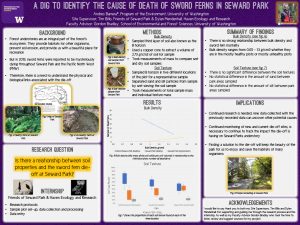A Dig to Identify the Cause of Death of Sword Ferns in Seward Park
For the past decade, sword ferns across the Pacific North West have been sharply declining with no identified cause; these ferns are an essential part of a forest’s ecosystem and are supported by the soils around them. Healthy soils provide plants the ability to access nutrients, retain water, and allow for air exchange, and although sword ferns are resilient plants, without the proper soils, a sword fern’s growth can be disrupted. The purpose of this research is to help narrow down a potential cause to the sword fern die-off. To accomplish this, I interned with Friends of Seward Park and Haven Ecology & Research, which have been allocating time and resources into identifying a potential cause of this phenomenon. As part of my internship, I collected soil samples from Seward Park and Schmitz Preserve Park; from the plots we laid out, I collected bulk density samples, followed by a set of soil texture samples. Results show that bulk density is at levels that are associated with proper root growth and moisture content is not low enough to constitute drought as a potential cause. Furthermore, Seward park symptomatic ferns have a higher moisture content. However, they are still producing fewer fronds than those sword ferns found at Schmitz Preserve Park, that are experiencing a lower availability of moisture. These results are significant because they help narrow down the probable causes associated with the die-off; thus setting up the prospect for further research on other aspects of the sword fern’s environment.
